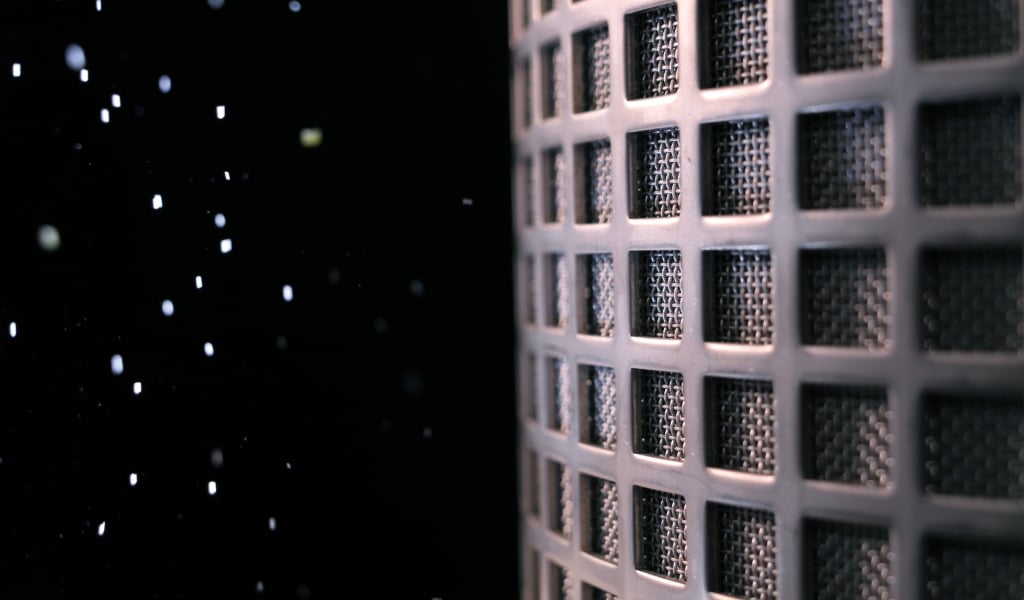Comparing Sintered vs. Multilayer Mesh Screens in Desalination
Desalination systems operate under extreme conditions including high pressure, corrosive environments, and continuous flow demands. In such settings, the choice of filtration media becomes critical. Operators often struggle with filters that clog easily, degrade under stress, or require frequent maintenance, leading to reduced efficiency and expensive downtimes. One of the most overlooked contributors to these issues is the mesh architecture of the filter screens themselves.
To address these challenges, engineers and plant managers are increasingly evaluating the performance of sintered bonded mesh versus non-sintered multilayer mesh screens. Understanding how these mesh types behave in desalination environments, especially in terms of cleanability, flow rate, head loss, and weldability, can help you to optimize system performance and reduce operational costs.
At W.S. Tyler, our mission is to help you create cleaner and safer filtration systems, backed by over 150 years of woven wire mesh expertise. We believe that the right mesh solution should not only meet technical specifications but also enhance long-term reliability and ease of maintenance in demanding applications like desalination.
In this article, we’ll explore the structural and functional differences between sintered and multilayer mesh screens, focusing on their performance in desalination systems. We’ll begin by outlining the benefits and limitations of sintered bonded mesh, then examine the cleanability and flow advantages of multilayer mesh. Finally we’ll provide a technical comparison of both mesh types, including weldability, cost-performance tradeoffs, and application-specific recommendations.
The Benefits and Limitations of Sintered Bonded Mesh Screens
Sintered bonded mesh screens are created by diffusion bonding multiple layers of woven wire mesh under high heat and pressure. This process fuses the mesh at every wire intersection, forming a rigid, monolithic structure with consistent pore geometry.
In desalination systems, especially those using reverse osmosis (RO), this structural integrity is crucial for withstanding high differential pressures and corrosive saltwater environments without deformation or delamination.
One of the standout benefits of sintered mesh is its mechanical strength and dimensional stability. The bonded layers eliminate movement between wires, ensuring uniform filtration performance over time. This makes sintered mesh ideal for deep filtration elements such as cartridges, discs, and pleated cylinders used in high-pressure pretreatment stages of desalination.
Additionally, the pore size remains stable even after repeated cleaning cycles, which is essential for maintaining consistent flow and filtration accuracy.
However, sintered mesh screens are less flexible and significantly more expensive than non-sintered alternatives. The rigid structure limits their adaptability in systems requiring complex geometries or retrofitting.
Moreover, the fused layers can create dead zones, which are areas between wires where contaminants may accumulate, which in turn makes them harder to clean thoroughly. While backflushing and ultrasonic cleaning are possible, these methods may not be as effective as with more open mesh designs.
While sintered mesh screens are known for their rigidity and precision, most manufacturers struggle to sinter high alloy specifications like AVESTA due to delamination risks. However, thanks to our extensive experience and technical expertise, W.S. Tyler is uniquely capable of overcoming these challenges all while delivering high-performance sintered mesh solutions even with demanding alloys.
In terms of weldability, sintered mesh does present challenges due to its rigidity and layered construction. However, when considering the specifications of sintered mesh, it actually behaves more like a solid metal sheet during welding, making it easier to weld than non-sintered fine mesh, which can be more delicate and prone to distortion. This sheet-like behavior allows for more controlled and consistent welds, especially when using corrosion-resistant alloys.
While fabrication may still require precision, the overall weldability of sintered mesh is often more manageable in practice compared to non-sintered alternatives.
Multilayer Mesh Screens: Cleanability and Flow Screens
Multilayer mesh screens, unlike their sintered counterparts, consist of stacked layers of woven wire mesh that are not diffusion bonded. This layered design allows for greater flexibility in both fabrication and performance tuning.
In desalination systems, particularly in pre-filtration stages before reverse osmosis (RO), multilayer mesh filters are valued for their high flow rates and low head loss, which contributes to energy efficiency and reduced operational strain.
One of the most significant advantages of non-sintered multilayer mesh is its cleanability. Because the layers are not fused, there are fewer dead zones where particles can become trapped. This open structure facilitates more effective backflushing and ultrasonic cleaning, which helps maintain consistent performance and extends the filter’s service life.
In desalination, where biofouling and particulate buildup are common, this ease of cleaning translates to lower maintenance costs and less downtime.
Interested in discovering more about the benefits of woven wire mesh and how it can help your desalination system? Discover more in our article below:
From a flow dynamics perspective, multilayer mesh filters offer lower resistance to fluid movement. The absence of rigid bonding between layers allows the mesh to flex significantly under pressure, promoting smoother flow paths and reducing turbulence. This results in lower differential pressure across the filter, which is critical in maintaining stable operation and protecting downstream RO membranes from pressure spikes and clogging.
In terms of weldability, multilayer mesh may appear more adaptable, but its layered structure introduces unique challenges. Because each individual layer must be securely captured during welding, achieving a consistent and reliable bond can be more difficult than with sintered mesh. In contrast, sintered mesh behaves more like a solid metal sheet during welding, allowing for smoother and more predictable welds. This makes sintered mesh comparatively easier to weld in practice, despite its rigidity, especially when working with corrosion-resistant alloys in desalination environments.
Sintered vs. Multilayer Mesh: A Technical Comparison
When selecting a mesh screen for desalination, understanding the technical tradeoffs between sintered and multilayer mesh designs is essential. Both offer unique advantages, but their performance diverges significantly in areas like cleanability, flow rate, weldability, and cost-effectiveness.
Cleanability is one of the most critical factors in desalination, where biofouling and particulate buildup can quickly degrade system performance. Multilayer mesh screens, especially those that are not sintered, typically offer better cleanability due to their open structure, which allows for more effective backflushing and ultrasonic cleaning.
However, sintered mesh screens are significantly more robust, making them well-suited for mechanical cleaning methods such as brushing or scraping. While they may have dead zones between fused layers that can trap particles, their durability allows for aggressive cleaning without compromising the mesh structure which can be an important advantage in systems requiring frequent maintenance.
Additionally, when evaluating cleanability within sintered mesh constructions, square or twilled weaves placed in the center layer tend to be easier to clean than finer weaves like MINIMESH. Their more open structure allows cleaning fluids to pass through more effectively, reducing the risk of trapped particles and simplifying maintenance routines.
Flow performance and head loss also differ notably. Non-sintered multilayer mesh typically offers higher porosity and lower pressure drop, which translates to better flow rates and reduced energy consumption in desalination systems. Sintered mesh, due to its rigid structure and tighter pore distribution, may restrict flow slightly more, leading to higher head loss. However, it compensates with precise filtration accuracy and consistent pore geometry, which is beneficial in applications requiring fine particle retention.
Weldability is another key consideration, especially when integrating mesh into custom housings or modular filter assemblies. While weldability depends on the specific mesh specifications, sintered mesh is often easier to weld because it behaves like a solid metal sheet. This sheet-like behavior allows for more predictable and controlled welds, reducing the risk of distortion or misalignment. In contrast, multilayer mesh, particularly non-sintered fine mesh, can be more challenging to weld, as each layer must be individually captured and secured during fabrication.
Finally, the cost-performance tradeoff is significant. Sintered mesh screens offer unmatched durability and precision, making them ideal for high-pressure, long-term applications. While they come with a higher upfront cost, their bonded sandwich structure secures the filter layer, reducing the risk of damage and contributing to a longer service life.
In contrast, multilayer mesh screens, though more affordable and easier to maintain, can be more vulnerable over time, as the unbonded filter layer is more exposed and prone to wear. At the end it always is based on the local water conditions, but the optimal choice depends on the specific demands of the desalination stage and the balance between performance, longevity, and operational efficiency.
Optimizing Filter Performance with the Right Mesh Screens
In desalination systems, the choice between sintered bonded mesh screens and multilayer non-sintered mesh screens plays a pivotal role in overall system performance. Sintered mesh offers unmatched structural integrity, consistent pore size distribution, and long-term durability under high pressure and corrosive conditions. On the other hand, multilayer mesh screens provide superior cleanability, lower head loss, and easier fabrication, making them ideal for applications where maintenance and flow efficiency are top priorities.
The optimal solution depends on the specific demands of your desalination process. If your system operates under extreme pressure and requires precise filtration with minimal deformation, sintered mesh may be the better fit. However, if your priority is maximizing flow, minimizing energy consumption, and simplifying maintenance, multilayer mesh screens offer a more flexible and cost-effective alternative. Understanding these tradeoffs allows engineers and plant managers to tailor filtration strategies that align with operational goals.
At W.S. Tyler, we are committed to helping you build cleaner and safer filtration systems, backed by over 150 years of expertise in woven wire mesh technology. Whether you're designing a new desalination plant or upgrading an existing system, our team is here to guide you toward the most effective mesh solution for your unique application.
Having issues with biofouling in your desalination systems? Discover why biofouling occurs, and learn some of the methods to help alleviate this problem for your system:
About Dylan Polz
Dylan is a Content Writer with 2 years of experience in marketing and SEO. Passionate about learning and strengthening his writing skills, he is currently expanding his expertise in particle analysis and woven wire mesh technologies. With a strong belief in the power of information to drive positive change, his goal is to develop content that supports cleaner, safer solutions across all industries.



